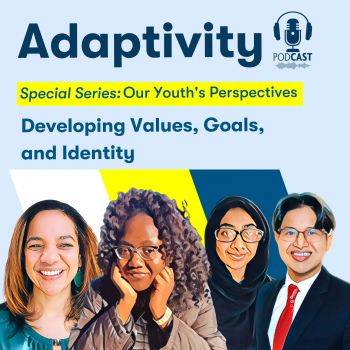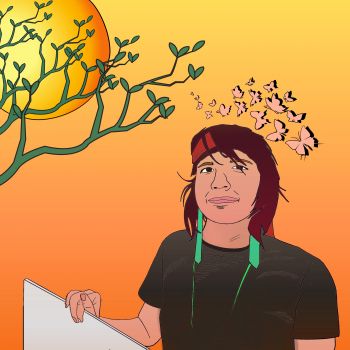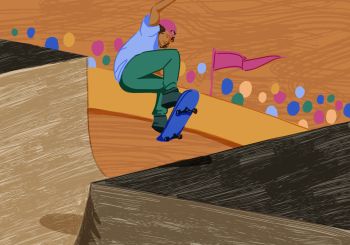Ron Dahl Adolescence is not a human social invention to extend opportunities for schools or apprenticeship; rather it’s a natural period of learning (extending beyond childhood) – for humans, but also many animals.
Barbara Natterson-Horowitz Having a brain, an adolescent brain that underestimates risk may be advantageous if the animal needs to leave the safety of home, the nest, the burrow in order to become a mature adult.
Ron Dahl For many species, adolescence is a time when individuals are actively learning and adapting to the complexities of their social world. This is true for humans and for our close relatives, chimpanzees
Rachna Reddy We see females during this period of time making these exploratory excursions to neighborhoods that aren’t the areas where their mothers typically range.
Ron Dahl It’s fascinating to observe the high stakes social learning that is essential for many animals to survive–and to thrive–as adults. And in many ways, these animals’ experiences can hold up a mirror to aspects of our own human adolescent years.
I’m Ron Dahl, founding director of the Center for the Developing Adolescent, and this is Adaptivity, where we explore the science of adolescence, untangling misconceptions about the years between childhood and adulthood. We explore new insights into the rapid cognitive, emotional, and social changes that happen during these years. And how the developing adolescent brain is primed to promote healthy and adaptive learning.
On this episode of Adaptivity, we’re going to delve into some fascinating new territory: thinking about adolescence when it occurs in other species.
Research into how animals experience adolescence has the potential to deepen our understanding of human adolescence. There are big differences, of course, but there are also some striking similarities in the quest to travel from the relative safety of childhood to the wider world of adulthood.
We’ll discuss the often perilous journeys chimpanzees and other animals make to explore this world and forge new relationships. And how their transition from clinging close to their mothers…to becoming full-fledged members of their communities can give us a new perspective on the importance of this period in our own lifespan–and how we can support positive development for our own adolescents.
We’ll talk with two scientists who study adolescence across species. A bit later, we’ll hear from bestselling author Dr. Barbara Natterson-Horowitz about how insights from the animal kingdom can help us better support human adolescents.
But first, we’re lucky to be able to talk with one of the leading researchers on the front lines of studying adolescence in chimpanzees. Rachna Reddy is a primatologist and biological anthropologist from Harvard who studies chimpanzees and bonobos in the wild.
Welcome Rachna.
Rachna Reddy Thank you so much for having me here.
Ron Dahl And so first, Rachna, can you just tell us a little bit about yourself and how you came to be interested in these questions?
Rachna Reddy I am a primatologist and anthropologist at Harvard University. And I think that the questions about adolescence in particular first became interesting to me the very first time I saw chimpanzees, which was not very long after my own adolescence. So I was 19 years old, and in my second year of college, third year of college, I got to follow chimpanzees in the wild.
Rachna Reddy There was this site where they wanted to habituate a new group of chimps to being followed by human researchers, and an adolescent chimpanzee from one group had traveled to the other.
So this was an adolescent female chimpanzee who’d grown up her entire life–she was 14-years old–being followed by humans, and she was not afraid of humans. And so when I went out to follow this group that was terrified of humans, she was the one chimpanzee who was not scared of me. And when she was around, other chimpanzees would allow us to follow. And that was a really special and a really unique experience and something that doesn’t happen often while you’re getting a new group of chimps used to being followed by humans. So I was very, very intrigued by this period she was in in her life and her name was Nora. And so from that point, I was very interested in studying that life stage.
Ron Dahl So I just want to focus for a moment on the fact that you’ve spent 11 years having long periods of observing carefully behaviors with a particular interest in adolescence. And in addition to writing papers and quantifying behavior and analyzing data, you have really gotten to know these individuals.
You really have a lot of anecdotes and story level understanding from going back month after month, year after year. Can you talk a little bit about that, that level of experience that you have?
Rachna Reddy So, yeah, it’s not just that I know the individuals, it’s that I spend hours, sometimes 13 hours every day and the longest stretch of time I’ve had there is 15 months. So it’s like sleep, sleeping in a tent, going out in the forest every day, following these individuals, being with them while they do pretty much everything that they’re going to do in a day. You get to know them and their behaviors, just like you know people that you are very close to.
Ron Dahl And how would you describe adolescence, the beginning of adolescence in chimpanzees, and when does it end [00:06:40] and to what degree is there an agreed-upon way of thinking about chimpanzee development?
Rachna Reddy So adolescence begins with the onset of puberty in chimpanzees, and this happens when they’re between eight and ten years old, though it varies for different individuals, just like it varies in humans, and it ends at the beginning of adulthood. And this for chimpanzees, just like for humans, is really a socially a social designation. So it’s at the moment that they’re considered to be a competent adult by their group members.
And that varies a lot demographically between different groups of chimpanzees and some characteristics that we as human observers consider to be moments that chimpanzees become adults are when they have their own offspring. For females, since they’re the individuals that are caring for the offspring, though, that can happen between when they’re as young as 12 years old, that’s quite young, and as old as 22 years old. So that’s a very different age range for having a first infant and being an adult.
And for males, they are considered adults by other male group members in particular. When they’re integrated into this hierarchy and receive a particular greeting from other males, which indicates that they are higher ranking and that greeting is called a pant grunt. And it sounds like this, “UH-UH-UH-HUH!!” This is a greeting that young chimps give to many adults when they’re young or even from early in infancy. Occasionally they even give them to human researchers. So we don’t fully understand what they mean, but they seem to be the sign of somebody who’s higher status than you. And adolescent males don’t receive those until they’re older.
Around age 16, we see that most male chimpanzees by that age receive pant grunts from females, from all adult females except their mother, and by their early twenties, they start to receive them from other males.
And this is something that varies a lot. At 16 years old in the group that I study, male chimpanzees are still pretty, that they’re low ranking, they don’t receive these pant grunts. But in a community just 18 kilometers away, so part of the same forest, the highest status male has been that young. That’s the situation where they were, like, many adult males in that community passed away.
So things change just like in human groups where you can become an adult at an earlier age or a later age just based on the social conditions of your community and what you learn and who else is there.
Ron Dahl So that’s fascinating on several levels. One is the similarities when you think about describing the beginning of adolescence as these early changes of puberty starting around eight or ten and ending somewhere between 16 and the early 20s. But depending on taking on social roles and situations, there’s a lot of parallels. And then the second part that’s fascinating is how long of a period adolescence is in chimpanzees, again comparable to humans.
Rachna Reddy So, a lot of species and especially very social species have a period between infants at the end of infancy when they’re weaned and the beginning of adulthood where they really start to reproduce and have their own offspring. That is a juvenile period. So this is a period that precedes puberty, and it’s a period with a lot of play and interactions with other individuals their own age often.
But what we see in chimpanzees is that they have a juvenile period. That period is over several years, but adolescence is often even longer than that juvenile period. And it is a period after puberty where they could have offspring, but they’re not socially considered an adult and they often haven’t finished growing taller.
Ron Dahl So, one of the things that I want to acknowledge and have you talk about some more, is that in order to understand at a deeper level what’s happening, we need to think separately about males and females. Because it sounds like, even from what you’ve already said, that the experiences are quite different, and the changes and challenges are different. Can you help us understand a bit about the male versus female adolescent experience for chimpanzees?
Rachna Reddy: Yes. So I will say that there are two reasons, I think, that we have to look at them separately. One is that during adolescence, female chimpanzees do something that is one of the most fascinating and unbelievable things I think you can witness in chimpanzee life, which is that they leave their group where they grew up and where they know everyone, and they go to a new group and they never see anyone from their group again.
I think that’s, it’s fascinating, because not only do they sever all these bonds completely during this period of time, but chimpanzees, even though they have close relationships with individuals in their group that can be very affectionate, they have completely hostile relationships with individuals from other groups, and they actually band together to kill chimpanzees from other groups; they fear being killed by those chimpanzees. Their whole life they spend really fearing for their life around strange individuals from other communities. And then during adolescence, female chimpanzees stop showing that fear, and instead they’re drawn to these other chimpanzees. And this is something that it happens in adolescence. And then once they have a new infant, once they have an infant in their new group, that kind of, that stops that type of calm and fascination and draw to the other community.
Males do not do this. They stay in the same community they’re born in for life and they stay with their brothers and their mother.
Ron Dahl What is known about what motivates the females to leave everything they’ve known, all the familiar places to get food, the relationships to leave all of that and go into what has up to that point represented hostile – a hostile and threatening context like other chimpanzees. What what? What do we understand about what motivates that to happen or triggers that to happen?
Rachna Reddy: First, from an evolutionary perspective, we know that this is a pattern that we see in any mammals that form social groups. We see that often one sex will disperse and one will stay. And this is thought to be a mechanism to avoid inbreeding.
But even on that level, it is very strange in mammals for those individuals to be females, because female mammals invest more heavily, energetically in their offspring just by pregnancy and lactation. Because of this, it’s more, it’s helpful for them to be in an area where they know how to find food and have social support of their mothers and sisters and other family members when they’re raising offspring.
From an evolutionary perspective, it’s weird. And then I think from a psychological perspective, it’s also quite mysterious and strange. I don’t know what they’re thinking. And I have to sometimes I think, like, I often wonder if other chimpanzees who never went through that think the same thing because they watch, you know, be it an intergroup encounter and other all the chimpanzees are screaming and running everywhere, displaying screaming. And these adolescent females will sometimes just sit in the middle calmly and look from side to side and sometimes just walk toward the neighbors slowly. The neighbors being these other chimpanzees, these enemy groups, they’ll just go toward them. And sometimes after those encounters, we have a new female immigrant that shows up in our group. They don’t always stay because they do make these visits where they visit other groups and then go back to be with their mother and other group members for a while.
But it’s really quite fascinating. The other thing that’s really mysterious about it is that there’s not conflicts with group members. This seems to be completely–to the adolescent female this is completely a positive draw to the other group. When they’re spending time with their mother and group members, their relationships are just as affectionate as before. But then they don’t seem to show any distress when they separate from the mother. They just go and they and they don’t show distress about being drawn to this very dangerous, something that was very dangerous to them their whole life. And then when they get there, this is something that’s even more profoundly makes this so mysterious to us–when they get there, this positive motivation can tend to be with the other group continues, even though the other group is pretty hostile to the immigrant female when she arrives.
Ron Dahl We know that in humans, adolescence is a critical time to form social bonds and build relationships outside of our immediate families. And adolescent chimps–both females and males–must forge social bonds outside the family in order to survive and thrive. How have you seen this play out within groups of chimps in the wild?
Rachna Reddy So adolescence in chimpanzees is a very special period for forming new relationships and having formative relationships and learning how to form them. So a big part of this, backdrop to this, is that until chimpanzees are 12 years old, so remember, adolescence can begin when they’re eight years old until they’re 12 years old. their best friend, you could say, or the individual they interact with most is their mother, and they’re almost always with their mother. They’re really always with their mom and they’re going where she goes. They’re socializing with individuals she socializes with, even though they play a lot with their peers as juveniles.
So there’s a couple of dimensions of things going on. So the first part is that they, this world of choices is open to them and they stop always making the choice to be with their mother. And that really happens around age 12. And when and when that happens, the choices that they make can vary a lot on an individual basis, and they do vary by sex as well because females leave, eventually leave their mother completely. So what we see is we see females during this period of time making these sort of exploratory excursions to neighborhoods that aren’t the areas where their mothers typically range. So they’re still group members, but they’re individuals that they’re a little bit less familiar with. And this is one of my favorite things to watch in chimpanzees.
So one summer, one of my early summers, this adolescent female Scarlett, she showed no hesitation in leaving her mother. She just went to this western neighborhood, and when she was there, she would follow these young adult males. So they were a little older than her. Never following older or high-ranking males. These were like males who are still low ranking in that young adult period, So between 16 and 20, and she would follow she followed this male, Wayne, he’s very sleek, and Wayne lies down to take a nap and Scarlett sort of lies down next to him to take a nap and just starts wiggles closer to him and just reaches out her finger to stroke his back.
There’s just a lot of this exploration and curiosity and in the social ways that female chimps get to do at this age, so they have this kind of special sexual freedom in adolescence to kind of follow and mate with whoever they want.
Ron Dahl I want to come back to these really important set of issues you were describing about learning how to navigate the exploration and success in forming different kinds of social bonds in adolescence. And I want to come back to what you’ve already described as this separation from this earlier period of always being close in proximity to the mother.
Rachna Reddy Yes and to clarify, it’s not they’re not always necessarily in close spatial proximity, but they’re in the same general group as she is. And so they’re in a range where they might be even a different tree in a big grove of trees. But if they scream, their mother will hear it and so often come over to help them. So it is, it is for protection. I think it’s also just that even if a juvenile chimpanzee doesn’t have a mother so that they lose their mother, they are almost never alone. It’s very rare for juveniles to be completely alone.
And then males often follow adult males, and they’re in there within their own group.
When male chimpanzees, when all chimpanzees are infants and juveniles, they receive a lot of affection from adult males. They tickle them. They play with them doing airplane play and sometimes making silly faces.
But what happens when adolescent males are about ten or 11 is that adult males just withdraw all of this affection. They stop grooming them, they stop tickling them, they stop or they stop gently playing in this particular, this sort of really affectionate way. And they ignore them. Around that time, or sometimes a few years later, adult males start to be really aggressive to adolescent males.
And it’s this very difficult period of time for adolescent males for this reason, because they are at this time trying to learn how to be an adult male. And they’re so motivated to follow adult males and go with them wherever they’re going. And they do this and leave their mother to do this, even though they show more distress than females when they leave their mother.
One thing that seems to help adolescent males is that they do groom with their peers if they have peers in their particular community. But they also tend to follow an older, like, an elderly male who’s no longer really high ranking, but often was previously a high ranking. In this particular community, where we have a lot of males living to older ages, this mentor male–it’s called a mentor in the literature–these elders, these mentor males, are often their biological fathers.
Ron Dahl Can you talk about the learning that’s going on in relation to the social relationships for the adolescent male chimpanzees across this multi-year period of time of their adolescence?
Rachna Reddy One part of, a big part of being a male chimpanzee is having close friendships like long-lasting relationships with other male chimpanzees that are reciprocal and dependable, and those relationships can help with a lot of different forms of social success.
So something like someone just hit you and you’re afraid and you want to embrace someone. Male chimps tend to do that with other male chimps, not with their mother once they’re adults. So when they’re really frightened, they want to go to someone else. When they’re having a conflict, somebody else supports them, not their mother. And to say that there are exceptions.
So sometimes when they have really severe injuries, they still go back and stay with their mother. But it’s, there’s something, this new type of bond is really important in their adult life. As an adult male chimpanzee, that’s not with their mother. And they need to learn how to be somebody that can be a reciprocal bond partner, somebody that others want as their bond partner, both how to invest and be invested in.
They’re also very important for things like patrolling the territory boundaries, which is a very dangerous activity and something that males do in groups together. Females also participate in patrols, but it can often be groups of all males and occasionally groups of all females. But in those activities, males need partners that they can really rely on and count on. They’re multiple parts, one, one, one part is that they need to learn how to have these reliable, affectionate relationships. And then the second part is that they need to learn how to cooperate in these different contexts and to do that with reliable partners and their partner previously is their mother, but that’s a specific–that’s a caregiver relationship, but a very specific type of relationship.
But it’s very different to be on a patrol with their mother versus to be on a patrol with all adult males and not their mother, who is, again, always watching out for them. And these patrols can be quite dangerous because they can meet an enemy group, they may kill them or they may be killed and they may also be killed if they’re left behind at some point when if they’re in enemy territory, they meet another group and they flee, for instance. it’s very dangerous to be left behind.
But for an adolescent chimpanzee to be out there and not know, they may not even know the exact boundaries of their territories in certain regions. They don’t they may not know exactly what to do when they meet neighbors. They may have never done it. They likely haven’t done it unless they have one of these mothers who also likes to patrol and brings them. They might get really tired and that might be really scary.
But they can’t leave. They can’t go home, they don’t know where they are. So this is a really, it can be really terrifying thing. They can go on patrols earlier, before adolescence, especially if they’re orphans. And being raised by a male caregiver, they often go on patrols. But in adolescence, they may make the choice to simply join, not because their mother is, not because their caregiver is, but because they on their own want to choose to go and not stay behind. And that’s something we see, we see to start happening around like 11, 12, but there’s so much individual variation.
Ron Dahl When you talk about these patrol-directed behaviors, even getting ready to go on patrol, you describe it as if it’s exciting, it’s dangerous, but it’s exciting. And we have for a long time, the field of adolescent development has focused on sensation seeking and thrill seeking as an important dimension of what happens as young people are exploring and taking more risks and learning as a function of this.
Is that your sense in some ways and that the social bonds and reassurance they give each other is fundamentally interwoven into this sort of excitement seeking or other other aspects of survival, the importance of defending their territory. How do you think about these issues in the patrol behaviors?
Rachna Reddy It is a very exciting, very risky social experience. And what makes it so…so even these individuals that love to patrol and might go on patrols on their own, they still are motivated to get other individuals to go with them. And of course, that’s because they’re likely to die on their own and much more likely to survive if their friends are with them.
But I think it’s like, it’s extremely exciting and thrilling as something to do together and it’s so entwined. It’s hard to separate it from it being something that they love to do because they’re socially bonded. It’s like we know they go on patrol more often when they’re with somebody that they’re bonded to. So that increases the likelihood that they’ll participate in a patrol. Those are things individuals who have bonds to do together. And so I think that it’s it’s yeah, it’s both. It’s like a risky activity, but it’s so embedded in the social behavior and the motivations for doing it are so social, and I will say, it’s especially risky for these young males. There’s an increase in mortality in this young adult-late adolescent period for males.
Ron Dahl So, this may be a strange question, but in cross-cultural studies of adolescents and their risk taking, one of the factors that seems to motivate that is it’s a way to gain admiration and status, to be brave, to be proving oneself. Is that an unfair question to imagine that there are situations where as adolescents and early adult males are participating in these boundary patrols, that they can somehow earn status or develop a higher relationship with higher ranked male. Could that be something that’s happening? And in these situations?
Rachna Reddy The way that they can establish their reputation is fundamentally different from the way that humans can in one important way, which is that they don’t have language, which allows them to share with each other information about events that one individual was present for and one wasn’t.
But, I do think that the intensity of bonding that happens during the patrol is something that on a dyadic level, so like individuals who shared that experience with a particular adolescent, I think that can fundamentally maybe can change their relationship and make them maybe value that adolescent in a way that they wouldn’t have before.
So I followed a cohort of adolescents who, many of them are, they’re all a lot of even the youngest ones are adults now. And I remember for a lot of them, the moment it’s a subtle moment, but something that seems profound to me is not the moment they went on a patrol, because that can happen sometimes just in a collective situation.
But the moment that they were just in a, like, pretty relaxed situation, but an adult male waited for them. So they were following, and following you often, it’s this adolescent male trailing after an adult. The adult, they go into a tree, they feed. The adult comes down from the tree, the adolescent with food in his mouth still his mouth full plummets down comes after the adult running, running, running, trying to finish eating while he’s running after this adult.
But the moment that doesn’t happen, so an adult male comes down from the tree, he’s done eating, the adolescent is still eating, and he sits there and waits. That happens for some males years earlier than it does for others, that somebody waits for them that way. And I wonder if that is perhaps things like going on a patrol. This is something we should look at, gives you that kind of value of like, okay, you’re somebody that does these things. You’re somebody I want to, I want to wait for somebody I’m investing in now, too.
Ron Dahl That’s fascinating. So it’s could it be almost a sign of respect that the willingness to wait for a younger–
Rachna Reddy Yeah, I think it’s a sign of like caring about the relationship at all, where, where and in so many ways for adolescents, it seems it’s completely one sided. You know, they give, they groom, they groom, they give, they follow, they initiate proximity, they initiate basically everything. And these other individuals and they’re so motivated to do that, even though they get really nothing back from the other individual.
That’s true for both males and females. Females, nobody even wants them in that community. For adolescent males, these adult males don’t even want them to be following and they keep doing it. And so the moment that there’s something given back to, I want you to be, you know, it matters to me that you’re following me or not. It’s huge. It’s like, yeah, I reckon it is a form of recognition.
Ron Dahl That’s so fascinating. Going back to the female adolescent version of this, this idea of it being high stakes with forming bonds, of successfully initiating, trying to initiate and then actually establishing a bond. And so in some ways, it’s totally different because now the females have a much riskier situation in many ways of having to go into this new group and try to create some kind of a relationship. And yet, there are similarities; it’s really high stakes.
Rachna Reddy Yes! So these situations are challenging and high stakes for both males and females. But because females are in a new group and because of the way that female status is constructed socially in these chimp groups, it is really, really, really high stakes during adolescence for females, more so than males.
We know from one study that was able to look at this that it seems like for females the status they hold as an adult. And this is a status that affects where they can feed, how often their infants survive. All of these factors that are really important for their social and their reproductive success, their evolutionary fitness, that status is determined in those adolescent immigrant years.
So what a female does during those years, the social position she comes in at, will affect her social position when she’s 40 years old. So it’s this extremely, like, what you do when you’re 14 affects what happens to you, where your kids can feed, when you’re 40 for a chimpanzee.
Ron Dahl So, Rachna, bringing our conversation full-circle, there are so many interesting insights we might learn from careful observation of adolescent chimps. I know why I’m so fascinated by adolescence, but I’d love to hear what questions you find most compelling about this life stage in the development of chimpanzees.
Rachna Reddy I think the questions that have always interested me most are how the same relationship can change so profoundly over time …And I think that the most interesting period of time to study that in is adolescence, because our identity is completely changed. How other individuals treat us completely changes, who we become to others completely changes. And that’s true for chimpanzees, too.
Things adult chimpanzees take as given are not taken as given by adolescent chimpanzees. There’s still, it’s still new to them. They’re surprised. There’s so much to understand about this time period–it’s the best.
Ron Dahl Well, thank you so much, Rachna, for joining us today and sharing so many insights about your research.
Rachna Reddy Thank you so much for having me on. This has been really fun.
***
Ron Dahl So Rachna offered us a unique set of insights about adolescence in chimpanzees, as they leave the safety of their mothers and sometimes their whole communities to build new connections and find new roles and identities in a broader social world. This set of transitions carries real risks, but also opportunities for crucial learning and discoveries.
And now, to further explore the valuable insights from looking at adolescence in other species, we turn to Dr. Barbara Natterson-Horowitz, a professor of medicine in the UCLA division of cardiology and a visiting professor in the department of human evolutionary biology at Harvard.
Her research explores how evolutionary perspectives from the natural world can be a source of insights for human health.
She co-wrote two bestselling books, Zoobiquity and Wildhood, with Kathryn Bowers.
I’d like to welcome you, Barbara, and ask if you could first briefly share a bit about your journey– the one that brought you from your medical background and directing a cardiac imaging program at UCLA to thinking in evolutionary ways about adolescence?
Barbara Natterson-Horowitz Great. Well, first of all, I’m really excited to be here, so thanks for the invitation. I was a pretty kind of traditional animal in the sense that I was a professor of medicine at an urban medical school, which meant I saw a lot of patients. I did a lot of teaching and I was directing one of our cardiac imaging programs.
And it was because of that, the fact that I was quite experienced at doing specialized ultrasounds of the heart, that I was contacted by one of the veterinarians at the Los Angeles Zoo in 2005. And they were asking if I’d come out and help them with some of the great apes who had cardiovascular problems. There was a chimpanzee who had had a stroke. There was a gorilla that they were concerned had a tear in his aorta, that sort of thing. That experience went on for a number of years. I was cardiovascular consultant to the Los Angeles Zoo, and it just completely opened up my eyes to this world of veterinary medicine.
And then more sort of relevant to my life as a physician, a doctor for humans, how much I could learn about my human patients, how much better I could understand them, how much better of a teacher I could be for my medical students by bringing this animal information into my work as a as a human doctor.
Ron Dahl Well, thank you. That was very, very interesting.
Sometimes when we’re trying to think about what we can learn from different animal species or looking at a disease or a process or development in a different species or in a different context, it’s a combination of not only similarities, but differences, and that by looking at similarities and differences, sometimes an underlying principle or insight can emerge.
I think one of the things that was most exciting for me and others that I know reading your book Wildhood, is how often that process occurred. That is the insight came about thinking about similarities and differences across different contexts, different species, different developmental processes. And I wonder if you can talk about that, not just a linear translation in terms of research, but this deeper set of insights by contrasting both similarities and differences.
Barbara Natterson-Horowitz Yes. And I’m thrilled that you as a physician picked that up. One of the really interesting things for me was in those first years, that first half dozen years was trying to figure out a way to take this animal experience and transform it into something that I could actually use that was scientifically meaningful. What I actually did was to develop a kind of a version of systematic review and meta analysis for looking not across clinical studies as we do in medicine, but rather across species for patterns and trends that might otherwise not be seen.
You know, one really interesting–and by the way, the first book, which was called Zoobiquity, was really an exploration of of shared vulnerability to heart disease and cancer and and sexual dysfunction and and a number of psychiatric problems–I started wondering, could there be significant homology–similarity–between animals that are very far apart, kind of from a common ancestry perspective? In other words, yes, chimps are very close, chimpanzees and humans, we’re the closest related animals, right, 6 to 7 million years ago is our common ancestor. But was there any developmental similarity between let’s say, a human infant and a walrus infant, right? Were there commonalities between animals simply based on the phase of life in which they might be?
I really, frankly, partly because I had emerging adolescents at that time Zoobiquity was published in 2012. And Kathryn Bowers, my co-author in both books and my partner in research and writing, she and I were thinking about what our next book would be. We both had sort of middle school and pre-middle school children. And so, yeah, we had adolescents on our mind.
And so I thought, Well, what are the things that I’m most worried about? My son, who is now 24, you know, driving was on the horizon. And I was worried about accidents, car accidents. And so you know, I knew the statistics since, you know, between the ages of 12 and 19, you as an expert in adolescence, you know this so well, but I mean, the risk of having an accident really just dramatically rises, mortality rises.
So I started wondering, well, does mortality rise in non-human animal adolescents? But before I could even develop a, you know, a kind of a methodology for answering that question, I had to determine whether or not nonhuman animals actually have adolescence.
Ron Dahl I was fascinated to read that you found a version of adolescence in so many different animal species–not all, to be clear–but hyenas, wolves, penguins, sea otters…
Barbara Natterson-Horowitz Kathryn and I spent five years studying non-human adolescents. It’s so obvious now that, of course, adolescence is not uniquely human. But I had read all kinds of literature from different fields, implying that or stating that adolescence was not only uniquely human, that it was the product of the 20th century or or post industrial revolution and all of this.
Yes, non-human animals do have adolescence, and we define adolescence as the period between the onset of puberty. So there’s a biological start. And on the other end of what we actually call “wildhood,” which is this kind of a species spanning period, it is when an adult animal emerges.
Ron Dahl Thinking about your kids driving and increased mortality for human adolescents, can you share your insights about how other species–wild birds, wild reptiles, amphibians, fish–encounter increased risks during this window? Do they have increased mortality at this phase of life?
Barbara Natterson-Horowitz There are studies that look at fledging birds, and the mortality of fledging birds. When a bird fledges, when a penguin fledges, these are animals that are now sufficiently grown, so their bodies are big enough that they can be outside of the protection of a parent. But they lack experience. They are what’s called predator-naive. They can’t feed themselves very well. They can’t find resources. They’re hunting and foraging skills are still not as developed as they might be.
Animals, including human animal adolescents when they are hungry, take risks that they otherwise might not take. And once this pattern, as you were saying, this pattern emerged, it was very exciting and really got us moving towards thinking first about, well, we talk a lot about the human adolescent brain. Is there a there a bird adolescent brain? Is there a, you know, a deer, adolescent brain and so on.
Ron Dahl So, if I can extrapolate, what I’m hearing you say is that adolescence represents a natural developmental stage for multiple species.
Barbara Natterson-Horowitz The question is a version of something that, the way that I like to start research projects, with the idea that human exceptionalism is exceptionally dangerous for humans. And I say that because there are so many insights that can be so clarifying for so many really challenging issues that we face, that to sort of allow history and culture to blind us to those insights is just, it’s dangerous.
So let me share one or two about safety, but then really focus on anxiety and emotion. And frankly, I’m going to kind of put myself back to where I was when my kids–I have a son and a daughter who are now in their twenties and seem to have survived adolescence as did I theirs.
So one of the first things that was among the safety issues, you know, there was this I remember when the kids were learning to drive, they got a kind of a provisional license. They weren’t allowed to be with other kids in the car without an adult.
And, you know, it made total sense to me. And I understood that they, apparently there was an increased risk taking when they were with peers. And in fact, if you don’t take an evolutionary perspective, the risk taking of adolescence, sort of the brain biology that underlies risk taking in human adolescents, it’s really hard to understand how that could be fitness-enhancing. In other words, how that brain biology that causes that degree of underestimating risk and impulsivity, etcetera, how that could enhance survival.
But if you pull back and look not across the last 200,000 years, which is our species, but rather across, you know, 25 million, that’s our common ancestor with gorillas. And then we pull back again at 200 million mammals, and then we pull back again. And, you know, we end up at 450 to 500 million years ago. Our common ancestor with fish, if we look that way at the adolescent brain and risk taking and the tendency for risk taking to increase, uh, with others, when we are looking broadly across species and we can look for patterns and trends, all of a sudden things start to make better sense because the one can begin to see that, well, having a brain, an adolescent brain that underestimates risk may be advantageous if the animal needs to leave the safety of home, the nest, the burrow in order to become a mature adult, have those experiences, find a partner and all that.
But it’s not only that. It turns out that one of the ways that adolescent animals–and I’m talking from mammals like meerkats and bats to minnows and guppies–I mean, it’s very wide across the tree of life. One of the things that they do to become safer, to gain knowledge about their predators, is that they do something called predator inspection. And predator inspection is a behavior where they come together in groups. It’s not done alone and they approach their predators.
There’s video that I now have of adolescent gazelle coming together and approaching cheetahs, or there are these meerkat that encircle Cape Cobra. And that predator inspection is, you know, animals who do it become safer and animals that don’t, don’t gain the knowledge of the things that are most likely to kill them when they’re on their own.
Ron Dahl So, what does this say about insights into the dangers of adolescence in human development? And why the DMV wants an adult in the car as adolescents are learning how to drive?
Barbara Natterson-Horowitz Well, I think one, I think a pretty solid hypothesis is that when you come together with other animals, there’s safety in numbers. And when adolescent animals come together, one of the tasks that can help them become safer as adults is this predator inspection. But it’s a scary thing to do. And if coming together with other peers has the effect of reducing the risk taking threshold, then to accomplish this important developmental task, then that’s a good thing.
So it may be that what the DMV requires is actually an echo of this ancient safety strategy. And it’s an adolescent brain-based safety strategy that’s seen across vertebrates.
Ron Dahl So much of the risk-taking and exploration that we see in human adolescents that resonates with so many of your observations is in addition to gaining knowledge about dangers, it’s to develop skills for dealing with complex challenges. And that includes, again, as you point out a number of times in your writing, gaining status and prestige, becoming socially competent, and the graduated license program, it probably protects in a really key window of time.
And I think, as you pointed out, the mastery that’s needed, the kinds of behavioral and emotional and social experiences that create that mastery, really depend on getting experience, trial and error, reinforcement learning experiences with real situations that are scary and have some risk and contain so much of the foundation of the learning that has to happen. And it sounds like that’s very true across a number of species, not just with humans.
Barbara Natterson-Horowitz It is. And one of the dangers, the greatest dangers and one of the most important skills is learning to navigate the social world, which is one of the core competencies of adolescence. And by the way, what I learned from this whole process is that human adolescence has been pathologized.
The adolescent brain is sort of treated as this object of fear. And the opposite is true. Once you look at the the evolutionary purpose of adolescence, it is really to gain those experiences that that are required to to gain what what Kathryn and I identified as four core competencies –becoming safe, developing the ability to socially navigate sexual competency with communication, and then self reliance. But the social piece is really, really important, and especially today, because learning to navigate social hierarchies in other species is directly connected to what a lot of adolescents are experiencing today, which is anxiety and depression.
But the idea that there are, in social animals, there are hierarchies, and higher-ranking animals tend to have better survival and they tend to reproduce more. And an animal’s social rank can determine whether it eats or it starves, whether it has offspring or not, whether it is allowed inside the burrow or whether it’s cast out. So an animal’s status can literally be a matter of life or death.
All right. So what does that have to do with modern, modern human adolescence? When there is a fall in status, what’s called status descent, what in the life of my own kids might be some humiliating event in the classroom or on this playing field or online, it is a terrible, terrible feeling. What I now really understand is, you know, when they would have these ups and downs socially, which is mostly what I remember about their adolescence, I can’t remember a single test I helped them to study for, but I remember some emotionally wrenching things that had to do with friends. They act as though it’s a matter of life or death. And what I wish I’d understood then, which I do understand now, is the reason that they felt that way. It’s not because they were being superficial or had bad values, but the reason that they felt that way is that the adolescent brain for so many millions of years has been dialed up to be exquisitely sensitized to status.
Ron Dahl Let me go to this area of the social learning, this intense social learning that can happen in adolescence, and I’d love to hear an example or two from the animal kingdom that that may highlight some of the similarities of this social learning that can be occurring in this in a formative way, in a really important, increasingly important way during adolescent development.
Barbara Natterson-Horowitz In the book, we used one species for each of the four core competencies. And for this the skill of navigating social hierarchies we use the spotted hyena because of course, spotted hyena societies are notoriously hierarchical. So status is really important. And the spotted hyena population that we were using is a very well-studied group in the Ngorongoro Crater in Tanzania that Oliver Hunter and a German group of biologists have been studying for many generations.
And we actually focused the story on Shrink, who was an adolescent, rather, he was a cub. He was born to the lowest-ranking female in that hyena group. And hyena society, as I said, is very hierarchical. It’s also matriarchal. So the females are always higher ranking than the males. And he was born to the lowest ranking female, but he was actually able to through social alliances, essentially friendships and a kind of hyena IQ kind of developing his social abilities. He was actually able to insinuate himself into a higher ranking kind of cohort.
It’s really a kind of a rags-to-riches hyena story. And probably not every hyena who is born that way might be able to do that. And yet it was clear and it is true in in many animal societies, the ability to form friendships, which is a skill which they have to build, the ability to develop coalitions and to be an individual who others want to be with, that those associations are as important as as anything in in sort of shaping their destinies.
Ron Dahl This process of mastering complex social learning and becoming socially competent seems to be particularly important in subsets of species for which these coalitions and complex hierarchies and some level of cooperation and bonding are particularly important, and so in some of the work in adolescent dolphins and adolescent chimps, these seem to be crucially important learning processes.
Barbara Natterson-Horowitz Yeah. The social learning, the spending time with peers, is critical, and not just in mammals, not even not just in great apes and in marine mammals. The species that you talked about, even in schooling fish, we looked at fish that were deprived of the opportunity to sort of play when they’re young, to sort of practice schooling behavior. They could never really school with the other fish that there is–the social…it’s not just having a social brain. The social brain has to be trained.
And that training, you know, some of it, of course, is going to be parental depending on the species. But much of it is getting in there with peers. And that is critical.
One of the other interesting things that the chimpanzee examples and certainly Shrink speaks to something else that exists in the wild, which is neurodiversity. And, you know, that’s a term that, of course, we hear a lot when we’re talking about kids in the classroom and different kinds of learners and all kinds of ways in which that term is used. But actually, neurodiversity and biodiversity are very closely linked. And it is fascinating to look at a herd of grazing ungulates, hoof stock or, you know, a group of animals. They have different temperaments. They have different personalities. Right. Some are more vigilant. Some are more social. Right. This is just absolutely part of what we see in nature.
And so, you know, to me, there’s something very, oh, I don’t know, illuminating about this concept of animal temperament and personality. It’s not destiny, but it does speak to animals coming at the social world from different places that they’re not all kind of…it’s not a level playing field.
Now, the other piece of this is that in the hyena society, it’s not a level playing field, and Shrink, I I can’t prove this, but I think Shrink had, was sort of born with what Oliver called a charisma, whatever that is.
But overcoming the odds. There were other things that kind of helped. And what we see in a lot of animal societies is that, you know, when Shrink was able to get care from the highest ranking female, that really changed things for him. Had that not happened, you know, the playing field would have been stacked against him. He would have not had as much milk. He would not have weaned as quickly and got into eating the meat that really builds up the muscle that they need for more dominance. He would not have had the help of the coalitions of his adopted mother that provided the social training and protection. So what all of this speaks to is who an animal, human or non-human, is born to and where where they’re born, whether there are resources or not, whether there are dangers or not really, really shapes their destinies.
Ron Dahl I really appreciate this optimistic perspective on adolescence as this window of time when this important learning can be shaped in positive ways and prosocial ways and really healthy ways. And I think increasingly that’s what the science of human adolescence has been supporting. It’s rather than think of this as a terrible time of hand-wringing and worry, but an incredible opportunity.
And the fact that having spent so much time and energy understanding cross species across the animal kingdom, you also have this optimistic view about adolescence as an exciting time of learning and opportunity is really inspiring. Any last thoughts or reflections in this space?
Barbara Natterson-Horowitz I agree. And what I love about thinking about it this way usually, I mean and I think I was even falling into that, talking about this sort of exquisite dialed up sensitivity to social status and all this, that actually the power of an evolutionary perspective, of a broad comparative perspective is that we can do something positive about it. And knowing that the adolescent brain is so sensitized to social standing that can be leveraged, that can be co-opted in a positive sense.
It’s like taking something that we’ve turned into going from hand-wringing about the adolescent brain to sort of an excited look at what we have. We have this incredible opportunity. We’ve got this, we know that this is the age of assessment. We know that for hundreds of millions of years, adolescent brains have been preoccupied with status. It’s an evolutionary preoccupation of adolescent animals, an ancient preoccupation. How are we going to offer them an environment where this can be leveraged for good? The animal adolescent brain evolved for important reasons to have this sensitivity to status.
And knowing that and having studied it and in so many other species, we’ve discerned patterns and trends and we’re going to use that information to help create schools and systems that, yeah, that that can place that in a positive context.
Ron Dahl Thank you so much, Barbara. We really appreciate your contributions and insights.
Barbara Natterson-Horowitz Oh, it’s been a wonderful conversation. Thanks for the invitation.
***
Ron Dahl So we’ve heard insights from two remarkable scientists about adolescence as a critical window for learning based on their research into development in other species.
Rachna’s study of chimpanzees shows clearly that adolescence is a dynamic period of social learning and risk taking as chimps begin to explore the world beyond the safety and close connections with their mothers.
Barbara has looked at adolescence extensively across species ranging from penguins, to whales, to hyenas. Her work shows us that adolescence has an evolutionary basis and is not just a construct of the modern human world.
Looking at adolescence where it occurs in other species raises compelling questions about the importance of finding ways to provide the guidance and resources to support our human adolescents to successfully navigate the risks and high-stakes social learning of our own increasingly complex world–helping them to explore and learn and hopefully become wiser.
I’m Ron Dahl, thanks for joining us on Adaptivity.
If you’d like to learn more about the science of adolescence, visit us at adaptivitypodcast.org or share your thoughts through the contact information at our website or by using the #adaptivitypod.
Our podcast is produced at UC Berkeley for the UCLA Center for the Developing Adolescent. Our senior producer is Polly Stryker. Our producer is Meghan Lynch Forder. Our engineer is Rob Speight. I’m Ron Dahl. Thank you for listening.
####

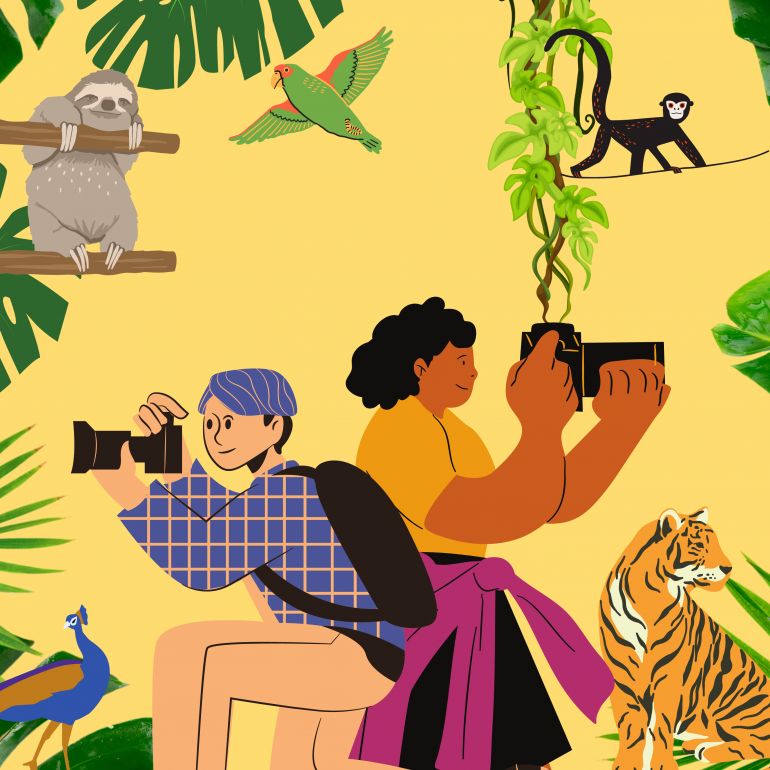
_350_350_80_c1.jpg)
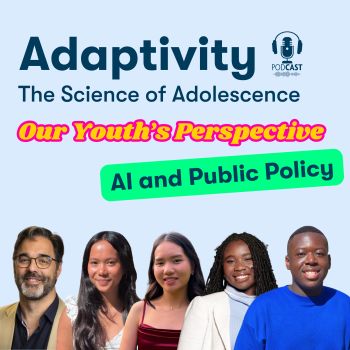
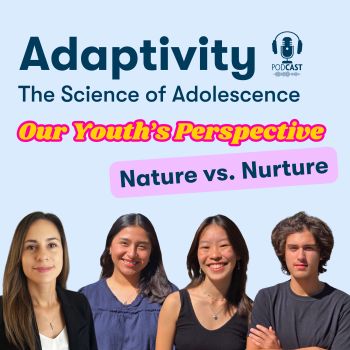
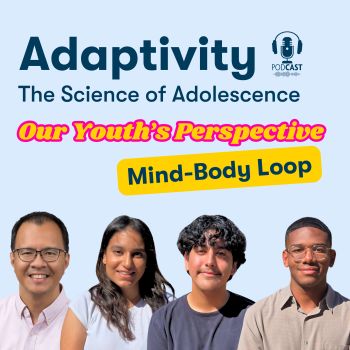

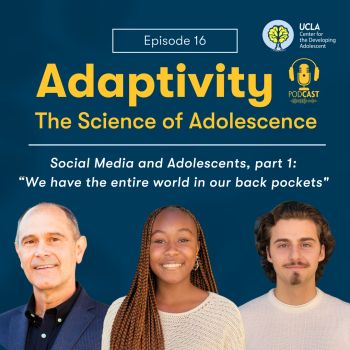
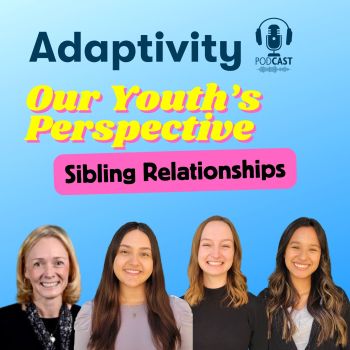
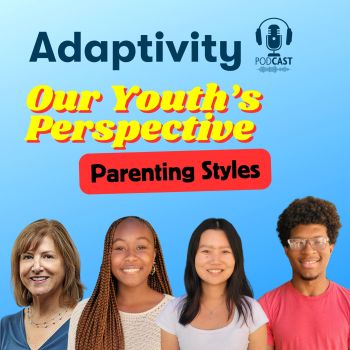
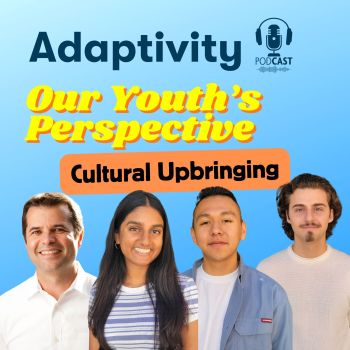
_350_350_80_c1.jpg)

